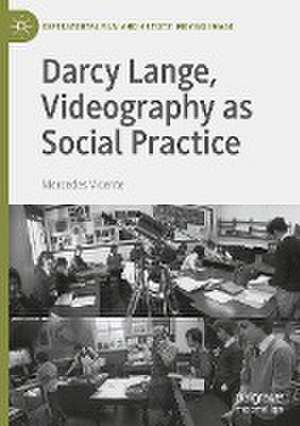Darcy Lange, Videography as Social Practice: Experimental Film and Artists’ Moving Image
Autor Mercedes Vicenteen Limba Engleză Hardback – 21 noi 2023
Preț: 729.84 lei
Preț vechi: 890.05 lei
-18% Nou
Puncte Express: 1095
Preț estimativ în valută:
139.67€ • 145.28$ • 115.31£
139.67€ • 145.28$ • 115.31£
Carte tipărită la comandă
Livrare economică 15-29 aprilie
Preluare comenzi: 021 569.72.76
Specificații
ISBN-13: 9783031369025
ISBN-10: 3031369025
Pagini: 278
Ilustrații: XVIII, 278 p. 45 illus.
Dimensiuni: 148 x 210 mm
Greutate: 0.51 kg
Ediția:1st ed. 2024
Editura: Springer International Publishing
Colecția Palgrave Macmillan
Seria Experimental Film and Artists’ Moving Image
Locul publicării:Cham, Switzerland
ISBN-10: 3031369025
Pagini: 278
Ilustrații: XVIII, 278 p. 45 illus.
Dimensiuni: 148 x 210 mm
Greutate: 0.51 kg
Ediția:1st ed. 2024
Editura: Springer International Publishing
Colecția Palgrave Macmillan
Seria Experimental Film and Artists’ Moving Image
Locul publicării:Cham, Switzerland
Cuprins
Chapter 1 Social Consideration, Communication, Observation: From Sculpture to Film and Photography.- Chapter 2 Ethnographic, Structuralist and Real-Time Filmmaking.- Chapter 3 Images of People at Work.- Chapter 4 Education, Participation, and the Making of the Subject.- Chapter 5 Social Activism.
Notă biografică
Mercedes Vicente is a curator, writer, and researcher. She is Associate Lecturer in Critical and Contextual Studies at the London Metropolitan University and was a lecturer at Royal College of Art, UK. She has held museum positions as interim Director of Education and Public Programmes at Whitechapel Gallery in London, Curator of Contemporary Art and Darcy Lange Curator-at Large at Govett-Brewster Art Gallery in New Zealand, and Research Curatorial Assistant at the Whitney Museum of American Art in New York.
Textul de pe ultima copertă
The Videography of Darcy Lange is a critical monograph of a pivotal figure in early analogue video. Trained as a sculptor at the Royal College of Art, Lange developed a socially engaged video practice with remarkable studies of people at work in industrial, farming, and teaching contexts that drew from conceptual art, social documentary and structuralist filmmaking. Lange saw in portable video a democratic tool for communication and social transformation, continuing the legacy of the revolutionary avant-garde projects that merged art with social life and turned audiences into producers. This book follows Lange's trajectory from his early observational studies to the crisis of representation and socially engaged video and activism, as it is shaped by, and resists, the artistic, cultural and political preoccupations of the 1970s and 1980s. It strikes a balance between being a monographic account providing a close analysis of Lange's oeuvre and drawing from unpublished archival materials—a sort of catalogue raisonné—whilst maintaining a breadth with theoretical discourses around the themes of labour and class, education, and indigenous struggles central to his work. The book's frameworks of Conceptual Art, structuralist and ethnographic film theory, social documentary and the critique of representation, video as social practice and the notion of 'feedback', participatory socially engaged art and postcolonial and indigenous theory,—expand our understanding of video outside the predominant structuralist tendencies. Lange's transnational and nomadic career introduces notions of alterity and challenges nationalistic accounts that excluded him in the past.
Mercedes Vicente is a curator, writer, and researcher. She is Associate Lecturer in Critical and Contextual Studies at the London Metropolitan University and was a lecturer at Royal College of Art, UK. She has held museum positions as interim Director of Education and Public Programmes at Whitechapel Gallery in London, Curator of Contemporary Art and Darcy Lange Curator-at Large at Govett-Brewster Art Gallery in New Zealand, and Research Curatorial Assistant at the Whitney Museum of American Art in New York.
Caracteristici
Focuses on a pivotal analogue videographer expanding the understanding of video’s predominant structural tendencies Considers video as a democratic dialogical tool for social transformation A materially modest, self-effaced, poignant critique of labour and class, education and indigenous struggles





